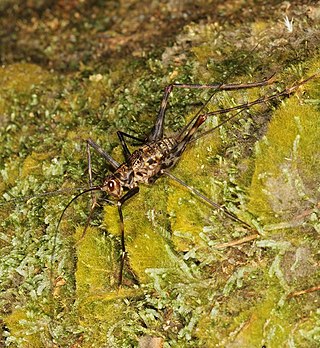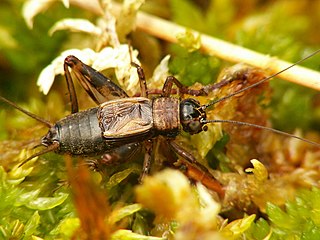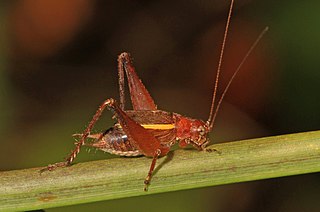
Gryllinae, or field crickets, are a subfamily of insects in the order Orthoptera and the family Gryllidae.

Tree crickets are insects of the order Orthoptera. These crickets belong to the Oecanthinae one of the subfamilies of the recently (2022) restored family Oecanthidae.

Trigonidiinae is a subfamily of insects in the order Orthoptera, suborder Ensifera, based on the type genus Trigonidium. They are often referred to as sword-tail crickets, winged bush crickets or trigs.

Gryllus is a genus of field cricket. Members of the genus are typically 15–31 mm long and darkly coloured. The type species is Gryllus campestris L.: the European field cricket.

Phalangopsinae, occasionally known as spider crickets, are a subfamily of crickets in the family Phalangopsidae. Members of Phalangopsinae are found worldwide in tropical and subtropical regions. Most species in the subfamily are nocturnal and can be found in rocky areas, near fallen wood, and the understory of forests. Some species are gregarious, gathering in large numbers.

The Eneopterinae are a subfamily of crickets, in the family Gryllidae, based on the type genus Eneoptera. It is one of several groups widely described as "true crickets", but this subfamily may also referred to in American English as "bush crickets". Of the more than 500 species that make up this subfamily, most occur in moist, tropical habitats. These insects are medium to large and brown or gray in color. They eat plant leaves, flowers, and fruits and can occasionally cause economic damage. Their eggs are deposited in pith, bark, or wood. Eneopterinae show a great diversity in stridulatory apparatus, signals emitted, and associated behaviour.

Mogoplistidae is a family of scaly crickets and allies within the superfamily Grylloidea. Considered to be monophyletic, a sister taxon to the Gryllidae crickets. This family consists of more than 370 species worldwide; 20 species in 4 genera occur in North America and this family includes the scaly crickets of Europe.

Nemobiinae is a subfamily of the newly constituted Trigonidiidae, one of the cricket families. The type genus is Nemobius, which includes the wood cricket, but members of this subfamily may also be known as ground crickets or "pygmy field crickets".
Hygronemobius is a genus of insects in the family Trigonidiidae.

Gymnogryllus is a genus of crickets in family Gryllidae and tribe Gryllini. Species are recorded from Africa, Asia and Australia.

Homoeogryllus is a genus of cricket in the subfamily Cachoplistinae and tribe Homoeogryllini. The recorded distribution is: Africa and Peninsular Malaysia.

The Hapithidi, previously placed as subfamily Hapithinae, is a supertribe of crickets in the family Oecanthidae and subfamily Podoscirtinae. It is one of several groups referred to in American English as "bush crickets", although this term can be confused with the Tettigoniidae.

Podoscirtinae is a subfamily of crickets in the family Oecanthidae.
The Phaloriinae is a subfamily of crickets of the family Phalangopsidae. Species are terrestrial and are distributed in: Africa, tropical Asia, Korea, Australia and the Pacific Islands.

The Euscyrtinae are a subfamily of crickets, in the family Oecanthidae, based on the type genus Euscyrtus. They are terrestrial and omnivorous and can be found in: Central America, Africa, Asia and Australia.
Aphonomorphini is a tribe of crickets in the supertribe Hapithidi. There are more than 90 described species in Aphonomorphini, all found in South America.

Gryllini is a tribe of crickets and typical of the family Gryllidae. Species are terrestrial, carnivorous or omnivorous and can be found in all continenents except Antarctica.
Luzarinaeis a subfamily of crickets in the family Phalangopsidae.

Ornebius is a genus of crickets in the family Mogoplistidae and the tribe Arachnocephalini, erected by Félix Édouard Guérin-Méneville in 1844. Species may be called "common scaled crickets" and have widespread records of distribution, which are discontinuous ; they include: Africa, Asia, Australia, islands in the Indian and Pacific Oceans, and South America.

The Oecanthidae are a recently (2022) restored family of crickets based on the type genus OecanthusServille, 1831. They include "tree crickets", "anomalous crickets" and "bush crickets" and can be found in warmer parts of most of the world.
















